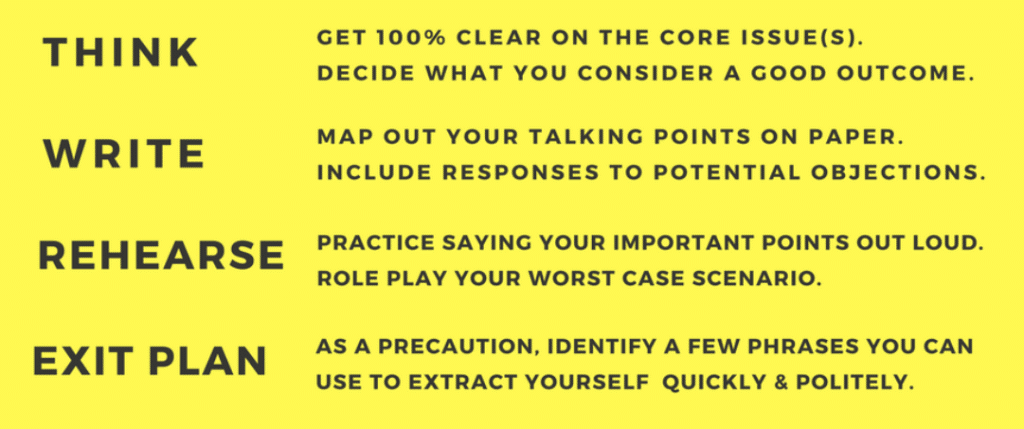Navigating through tough conversations is an art interlaced with the science of human psychology. Whether it’s a workplace dispute, a challenging negotiation, or a personal conflict, handling such interactions easily is invaluable. Many shy away from these talks due to the potential for conflict and the emotional charge they carry. However, those who master the art of managing these dialogues often find improved relationships and outcomes on the other side. This article explores practical strategies that help steer difficult conversations toward a positive resolution, providing readers with the tools to approach these daunting interactions with confidence.
Contents
Understand the Underlying Issues

Before diving into a difficult conversation, it’s crucial to discern the real issues at play. Often, what surfaces in the heat of the moment are symptoms rather than the root cause of the discord. A leader confronting an underperforming employee, for example, must look beyond the lackluster sales reports and seek deeper performance drivers. Is it a lack of motivation, insufficient training, or personal problems at home? Only by identifying the true source can the conversation aim to be constructive rather than accusatory.
Moreover, understanding the underlying issues paves the way for empathy, a key ingredient in managing difficult discussions. It’s common for personal emotions and history to color one’s perception of the present situation. Recognizing this helps maintain objectivity and steers the conversation away from blame and toward mutual understanding.
Preparation is Key

Preparation is the scaffolding upon which successful, difficult conversations are built. It involves gathering relevant information, setting achievable objectives, and considering potential reactions from the other party. In the context of a business negotiation, for instance, one must be well-versed not only in their terms and conditions but also in understanding the interests and limits of the counterpart. This dual perspective equips one to make informed concessions and stand firm on critical points, making the dialogue productive.
Planning also entails scripting the tough parts of the conversation. Predicting contentious points and preparing clear, concise responses can prevent being caught off-guard. This doesn’t mean the interaction should be rigidly scripted, but rather that one should have a well-thought-out framework to guide the discussion.
Initiating the Conversation

The commencement of a difficult conversation sets the tone for what follows. Choosing the right time and place is as strategic as the dialogue itself. A setting that ensures privacy and is free of interruptions underlines the importance of the conversation and shows respect for all parties involved. Initiating the dialogue with a neutral and open-ended question helps to engage the other person without putting them on the defensive.
Furthermore, non-verbal communication often speaks louder than words. A calm demeanor, steady eye contact, and open posture create a non-threatening environment that encourages open dialogue. Even when initiating a conversation that is bound to be charged, such as discussing a sensitive issue with a family member, these non-verbal cues are integral to maintaining a constructive exchange.
Active Listening

Once the conversation is underway, active listening becomes essential. It involves fully concentrating, understanding, responding, and remembering what is said. This is more than just a passive act of hearing. When a customer is voicing complaints, it is the difference between providing a generic solution and addressing their specific concerns effectively. Reflective listening, which includes paraphrasing the speaker’s words, validates their concerns and confirms understanding.
The challenge is to listen without preparing a rebuttal or letting bias cloud comprehension. This means setting aside one’s agenda to truly hear the other person. It is the foundation for a resolution that is not just agreeable but also sustainable. Active listening can turn a confrontation into a shared problem-solving exercise, changing the dynamic of the entire conversation.
Managing Emotions

Managing emotions, both one’s own and those of the other party is a delicate balance in any difficult conversation. Recognizing when emotions are starting to escalate is crucial. If a manager notices their frustration rising in response to an employee’s excuses, it’s a signal to employ techniques like deep breathing or pausing to regain composure. The same is true for noticing a client’s mounting agitation; acknowledging their emotions can help to de-escalate the situation.
Maintaining a calm voice, pausing before responding, and using ‘I’ statements to express one’s feelings without assigning blame effectively keep the conversation on track. These techniques foster a safe environment where all parties feel heard and respected, thereby reducing the likelihood of emotional outbursts that can derail the discussion.

Staying focused is particularly challenging when the conversation hits a snag or veers into less relevant territories. It requires the skill to gently steer it back on course without dismissing the other person’s points. When two partners in a business are at odds over the company’s direction, for instance, it’s important to acknowledge each other’s vision while also working to find common ground. This may involve compromising and agreeing on steps that align with both perspectives.
Tough moments are also opportunities to demonstrate commitment to the relationship and the resolution of the issue at hand. It might mean taking a break when emotions run high, or neither party can see eye to eye to reconvene with clearer heads.
Finding Resolution

Achieving resolution is the goal of any difficult conversation. This doesn’t necessarily mean reaching an agreement but finding a path forward. Summarizing the conversation’s key points helps ensure that all parties have a shared understanding of what has been discussed. From there, establishing actionable steps with clear responsibilities cements the conversation’s progress.
When resolution seems out of reach, setting a time to revisit the discussion can be invaluable. It’s a commitment to continue working on the issue together, recognizing that some problems don’t have immediate solutions. The aim is to leave the conversation with a sense that progress has been made, even if it’s incremental.
The Follow-Up

Post-conversation follow-up is often what solidifies the outcomes and ensures accountability. It involves confirming actions taken and reviewing any agreements made. In a workplace setting, this could mean sending a summary email after a meeting where difficult topics were addressed, outlining everyone’s next steps. It’s also a chance to offer feedback on the conversation process itself, which can strengthen future interactions.
The follow-up is a critical component of the conversation cycle that fosters trust and shows commitment to the agreed-upon resolutions. It’s also an opportunity to address any new concerns that may have surfaced since the original discussion, ensuring the dialogue remains open and productive.
The Bottom Line
Handling difficult conversations easily is not an innate talent but a cultivated skill that yields numerous benefits, both personally and professionally. By understanding underlying issues, preparing thoroughly, and approaching these exchanges with the right mindset and strategies, individuals can transform potentially contentious interactions into opportunities for growth and resolution. The ability to navigate through the turbulent waters of challenging dialogues is an empowering asset, and with practice, anyone can become adept at it. Embracing these moments with confidence and clarity not only leads to better outcomes but also contributes to stronger, more resilient relationships.
